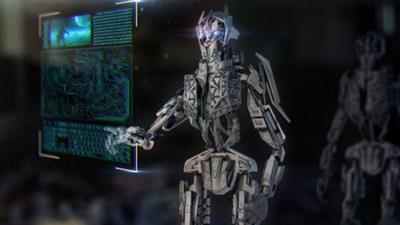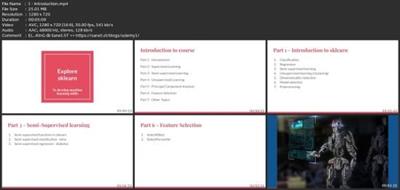Explore Sklearn
Published 10/2022
MP4 | Video: h264, 1280x720 | Audio: AAC, 44.1 KHz
Language: English | Size: 2.90 GB | Duration: 6h 16m
to develop machine learning skills
What you'll learn
Students will learn about sklearn, Python's machine learning library
Students will learn about and go over the code of supervised learning classification and regression problems
Students will learn about and go over the code of semi-supervised classification and regression problems
Students will learn about and go over the code of unsupervised regression problems
Students will learn about and go over the code of principal component analysis
Students will learn about and go over the code of feature selection techniques
Requirements
Basic Python programming is a prerequisite to this course
Description
This course is intended to give the student an overview of Python's machine learning library, sklearn. The course is broken down into seven sections, being:-1. Introduction2. Supervised learning3. Semi-supervised learning4. Unsupervised learning5. Dimensionality reduction6. Feature selection7. Other topicsThe student will receive extensive guidance on how to use sklearn. Sklearn's search engine will be used to research sklearn's many functions, which include:-1. Preprocessing functions2. Classification models3. Regression models4. Semi-supervision models5. Clustering models6. Dimensionality reduction functions7. Feature selection functions8. Metrics functionsIn addition to learning about the numerous and varied types of functions in sklearn, The student will go over the code of twelve Jupyter Notebooks. The subject matter of these notebooks are:-1. Supervised classification problems2. Supervised regression problems3. Semi-supervised classification problems4. Semi-supervised regression problems5. Unsupervised classification problems6. Dimensionality reduction7. Feature selection by selecting the best features 8. Feature selection by selecting a percentage of the best features9. Logistic regression versus decision tree 10. The machine learning life cycleThe student will, using sklearn and other coding, cover the entire machine learning life cycle from the beginning to the end. This will cover:-1. Creating a Jupyter Notebook in Google Colab2. Importing Python libraries into the Jupyter Notebook3. Loading the dataset from either sklearn, openml, or Github4. Cleaning the data by taking care of any null values5. Encoding the data to covert object features to numeric features6. Using visualisation techniques to analyse the data7. Removing any outliers from regression models where necessary8. Removing any feastures that have a high correlation where necessary9. Reducing the dimensionality of a dataset where necessary10. Reducing the features of a dataset where necessary11. Assigning dependent and independent variables12. Splitting the dataset into training and validation sets where necessary13. Selecting the most appropriate model14. making predictions on the model15. Analysing the accuracy of the model by using metric functions
Overview
Section 1: Introduction
Lecture 1 Introduction
Lecture 2 Introduction to sklearn
Section 2: Supervised learning
Lecture 3 Sklearn classification models
Lecture 4 Supervised classification
Lecture 5 Sklearn regression models
Lecture 6 Supervised regression
Section 3: Semi-supervised learning
Lecture 7 Sklearn semi-supervised models
Lecture 8 Sklearn semi-supervised functions
Lecture 9 Semi-supervised classification
Lecture 10 Semi-supervised regression
Section 4: Unsupervised learning
Lecture 11 Sklearn unsupervised models
Lecture 12 Unsupervised breast cancer dataset
Lecture 13 Unsupervised wine dataset
Section 5: Principal component analysis
Lecture 14 Sklearn PCA models
Lecture 15 Principal component analysis
Section 6: Feature selection
Lecture 16 Sklearn feature selection models
Lecture 17 SelectKBest
Lecture 18 SelectPercentile
Section 7: Other machine learning topics
Lecture 19 Logistic Regression versus Decision Tree
Lecture 20 Machine learning life cycle
Beginner Python developers who would like to learn machine learning techniques
Download link
rapidgator.net:
uploadgig.com:Kod:https://rapidgator.net/file/4b99b679afba77ee7ab6cc51987c2d5b/srpvq.Explore.Sklearn.part1.rar.html https://rapidgator.net/file/d1b7e7bc4bd898b1e75cf69b3b23c01c/srpvq.Explore.Sklearn.part2.rar.html https://rapidgator.net/file/9b136fffa7bdc8b7118ee6787e30a236/srpvq.Explore.Sklearn.part3.rar.html
nitroflare.com:Kod:https://uploadgig.com/file/download/81934f9AD576Ad35/srpvq.Explore.Sklearn.part1.rar https://uploadgig.com/file/download/92c69Ca689ae0e57/srpvq.Explore.Sklearn.part2.rar https://uploadgig.com/file/download/93108e60d8adb6CD/srpvq.Explore.Sklearn.part3.rar
1dl.net:Kod:https://nitroflare.com/view/F564D001D6F0650/srpvq.Explore.Sklearn.part1.rar https://nitroflare.com/view/D25EC98F8414103/srpvq.Explore.Sklearn.part2.rar https://nitroflare.com/view/2ABC33A2A99260A/srpvq.Explore.Sklearn.part3.rar
Kod:https://1dl.net/3ifh4i1ly3gm/srpvq.Explore.Sklearn.part1.rar.html https://1dl.net/9w9t6t678her/srpvq.Explore.Sklearn.part2.rar.html https://1dl.net/7a3b268wo7f2/srpvq.Explore.Sklearn.part3.rar.html
1 sonuçtan 1 ile 1 arası
Konu: Explore Sklearn
-
17.10.2022 #1Üye



- Üyelik tarihi
- 20.08.2016
- Mesajlar
- 148.401
- Konular
- 0
- Bölümü
- Bilgisayar
- Cinsiyet
- Kadın
- Tecrübe Puanı
- 158
Explore Sklearn
Konu Bilgileri
Users Browsing this Thread
Şu an 1 kullanıcı var. (0 üye ve 1 konuk)



 LinkBack URL
LinkBack URL About LinkBacks
About LinkBacks






 Alıntı
Alıntı
Konuyu Favori Sayfanıza Ekleyin